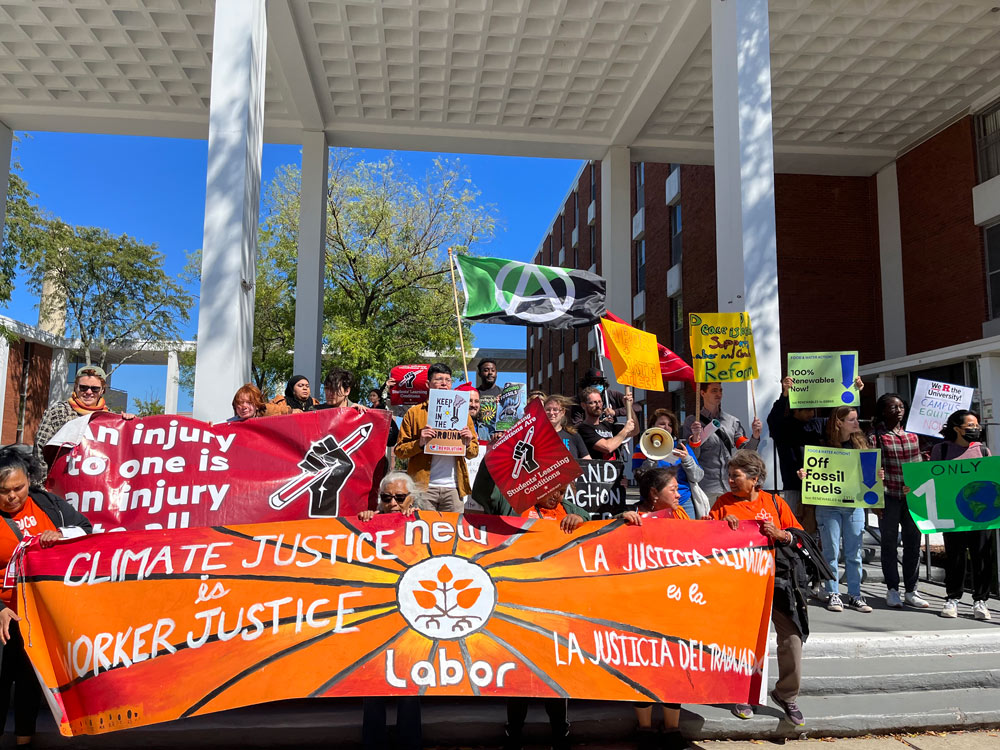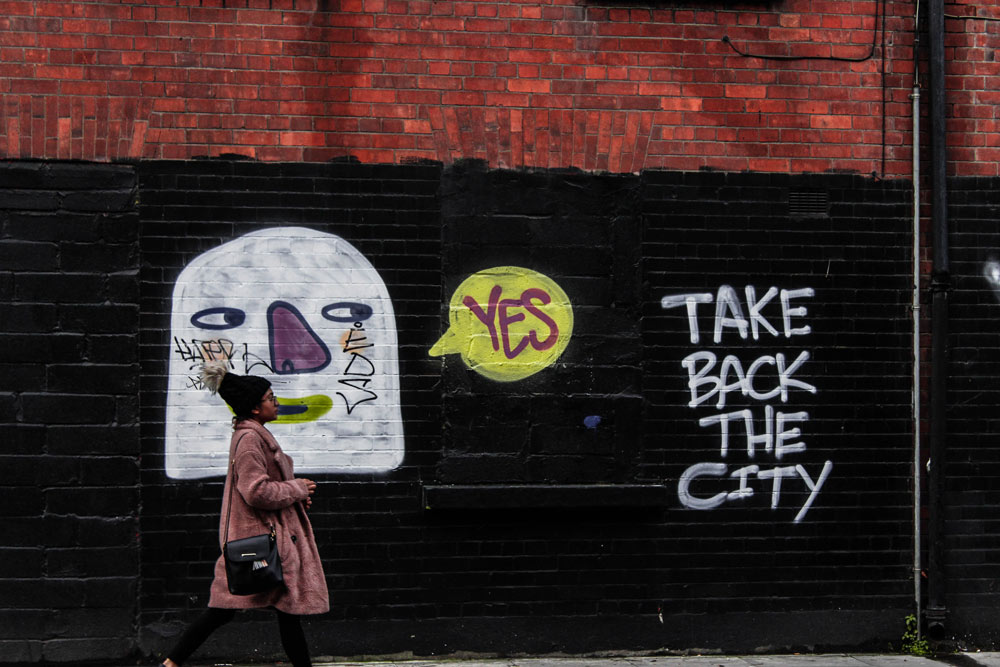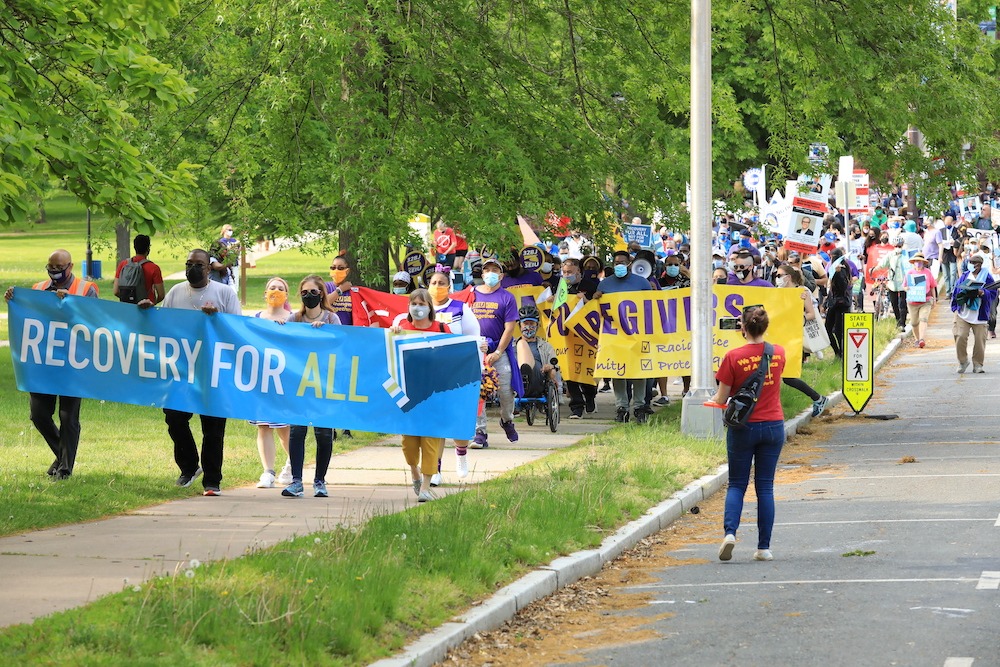
This article is the seventh installment in our series co-produced by Bargaining for the Common Good and NPQ, titled Building a Movement for the Common Good. In this series, we learn how and why Bargaining for the Common Good (BCG) is the right strategy for our times of social crisis, featuring extreme wealth inequality and declining democracy as well as a renewed attention to labor organizing and mass uprisings for racial justice. The authors reflect on how organizing in higher education can take on the corporatized university by connecting campus to community.
Rutgers University alumnus Mark Hopkins remembers being cheered on by a group of over 200 higher education organizers when he hopped on stage and delivered an impromptu speech about student demands at the 2018 “Bargaining for the Common Good in Higher Ed” conference at Rutgers, New Jersey. The gathering encouraged participants to reimagine higher-ed contract campaigns as tools with which to win broader common good demands co-developed by student and community groups.
At the time, Mark was one of many students organizing for a $15 hourly minimum wage with Rutgers USAS Local 109 (United Students Against Sweatshops). Rutgers faculty unions, who were advocating for the students’ wage demand, brought the fight for $15 to the bargaining table during their negotiations. In hindsight, Mark says, the conference was his “aha moment” for finding a home in the labor movement.
The conference’s goals resonated with him, he said. “I was being educated about the labor movement, but also not feeling like I have to compromise my social justice commitments to my community and my people in order to join…or contribute to this movement,” he says. “It felt like I was still supporting and contributing to the larger struggle of the fights that are part of my life.”
Today, Mark is a staff organizer with Rutgers AAUP-AFT, the full-time faculty, graduate worker, postdoctoral associate, and counselor union, where he helps design the union’s Bargaining for the Common Good strategy. The strategy brings Rutgers AAUP-AFT together with New Labor, a worker center representing Spanish-speaking communities in New Brunswick and across the state; Cosecha NJ, an advocacy organization focused on the rights of undocumented immigrants; and student groups on campus. This fall, workers, students, and the community will work together in a shared campaign both on the ground and at the bargaining table.
Community, Worker, and Student Power
The corporatized higher education system and the capital accumulation projects embedded in it depend on extracting labor from working-class people, disproportionately from vulnerable backgrounds. Historian Davarian Baldwin has described this “modern-day company town” effect, where colleges and universities control everything from wage ceilings to housing prices at both the campus and city levels.
To respond to these systemic issues, the Rutgers-based coalition has embraced a guiding vision for forging a strategy—crafted by and for workers, students, and the community—to create a socially just university. Such a vision not only invigorates campaigns, but builds alignment across what Baldwin has called higher education’s new “shop floor,” which extends from our campuses into our communities. “When we see higher education not as a place cut off from the rest of society, but as an institution embedded within cities,” Baldwin explains, “then we can begin to offer some materialist analysis that connects the campus to the city, to city hall, to the statehouse, to the shop floor. The campus is the shop floor for the city.” Only via an alignment of higher ed workers, students, and the community can we harness the power to re-imagine our public universities.
The 2018 conference at Rutgers, which brought together community and racial justice leaders from 50 campuses across the country, was a critical step toward organizing across the new shop floor. Professor Deepa Kumar, then president of Rutgers AAUP-AFT, worked to commit the union to the fight to protect DACA students and organize against Trump’s travel bans. But there were limitations to the traditional model of union organizing. The union was primarily reacting, rather than proactively integrating community needs into its contract campaign strategy. “While we had built relationships with community-based organizations, we had yet to make community demands part of our contract negotiations, and we wanted to learn from the experience of others,” says Kumar.
Kathleen Brower, Organizing Director for Bargaining for the Common Good and a fellow at Rutgers’ Center for Innovation in Worker Organization, argues that bargaining for the common good in higher education starts with the knowledge that everyone is being hurt by the increasingly corporatized management of universities. She sees bargaining as “a nexus of power” and “a legal mechanism that can be leveraged beyond workers and their own issues to actually win improvements that communities and students have been fighting for for years.” The key to winning is to bridge fights—from students fighting against sweatshops, to workers fighting for higher wages, to tenants fighting for lower rent—which are less powerful when separated. “When we see our interests as aligned—when we see that we do have the same interests and that the same people are holding us back—then we can work together and have real power to win more.”
Interconnected Fights
Labor and social justice coalitions must grapple with the many ways that universities govern far beyond campus walls. Universities in the US took shape in a settler-colonial environment, and axes of privilege based on class, race, sex, and country of origin have long determined whose interests are represented at the bargaining table. These connections mean that higher education organizing cannot be separate from larger liberation movements.
As with any union organizing, the first step in building a campaign is to have conversations about people’s concerns and desires and craft demands around them. Shortly after the 2018 conference, New Labor, Rutgers AAUP-AFT, and a coalition of student organizations called Rutgers One launched a survey of students and community members in New Brunswick.
From April through August, students and New Labor members knocked on hundreds of doors, reaching some 100 short- and long-term New Brunswick residents. The survey revealed that better, more affordable housing was a top concern for most residents and that many landlords preferred student over non-student renters. It also highlighted other concerns, including low wages both on and off campus, lack of free parking, and high rates of parking tickets near Rutgers.
It became clear that, as the largest landlord in New Brunswick, Rutgers has an immense impact on the city’s cost of living. When Rutgers set high prices for room and board, other landlords also raised their prices, and developers were encouraged to build housing complexes that were unaffordable for many.
The summer 2018 survey was critical in highlighting housing as an issue and suggesting a foundation for the coalition to build on, in tune with renters across the nation who are mobilizing against astronomical rent hikes. Coalition members took on an issue shared by most people who live, work, teach, and study in the region. In so doing, they prepared themselves to mobilize alongside housing justice organizers across the country.
Sign up for our free newsletters
Subscribe to NPQ's newsletters to have our top stories delivered directly to your inbox.
By signing up, you agree to our privacy policy and terms of use, and to receive messages from NPQ and our partners.
Lincoln Annex is NOT for Sale
While the coalition was gearing up its campaign, a battle erupted that forced everyone to change focus. In the fall of 2019, Rutgers University, Robert Wood Johnson University Hospital, and DEVCO, a real estate firm with a nonprofit designation, announced a $750 million expansion of the Rutgers Cancer Institute. A new facility would be built across the street from the hospital, necessitating the demolition of Lincoln Annex Middle School, one of the region’s best-performing schools. Displaced students would be located to a makeshift facility housed on a contaminated, toxic warehouse site. The fight that ensued between community members and the political elite was a classic illustration of community disenfranchisement and unmovable corporate agendas.
Rutgers professor Lilia Fernandez said she learned about the plan through her community organizing and immediately felt it was important for her union and the larger Rutgers community to get involved. “The New Brunswick student population is almost a hundred percent Latino children, mostly low-income, working-class children of immigrants, many of them undocumented,” Fernandez said, “I knew that this was a very marginalized population that did not have a whole lot of power or rights here locally.”
In the months that followed, parents, students, faculty, and community members formed the Coalition to Defend Lincoln Annex School. Rutgers AAUP-AFT and student coalitions joined to protest the proposal, and in late January 2020, people rallied during the public comment section of the Rutgers Board of Governors meeting. Many parents of Lincoln Annex students spoke out, along with Rutgers students and faculty.
However, as the fight began to pick up steam, the COVID pandemic struck, making it increasingly difficult for the community to successfully oppose Lincoln Annex’s destruction. That didn’t stop the grassroots organizing. In May 2020, a caravan of vehicles and socially distanced activists marched and rode through New Brunswick, insisting that “¡Lincoln Annex no se vende!” (Lincoln Annex is not for sale!) Throughout spring and summer 2020, Zoom emerged as a new battleground; at virtual Board of Governors meetings, the administration muted participants and restricted speaking time.
With Rutgers students demanding a reduction in tuition fees during the pandemic and faculty and staff reeling from mass layoffs and budget cuts, coalition and community alignment stayed strong. A September 2020 masked rally under the slogan, “March4RLivesRJobsRSchools,” drew connections between increased precarity and vulnerability for lower-income Rutgers students and part-time faculty and the ongoing fight to defend Lincoln Annex.
Despite these efforts, the fight to save the school was ultimately lost. But community pressure forced the New Brunswick Board of Education to allocate an extra $25 million to the development of a new school in a more suitable location. The coalition that formed to spread the word, create art and documentaries, and mobilize for both New Brunswick Board of Education and Rutgers Board of Governors meetings had a long-lasting impact on all the communities involved.
In reflecting on the campaign, Lilia Fernandez says, “I think one of the most important lessons that I take away from all of this is the importance of union members being responsive to and taking an interest in the local communities where they operate…We have a responsibility to our neighbors, the least among us, those in our communities who do not have as much power or privilege as we do, to be strong allies, support local struggles, and help defend people’s rights at really critical moments.”
Next Steps for a Growing Coalition
When the 2022-23 academic year begins, members of Rutgers AAUP-AFT will be working without a contract; their previous contract expired on June 30, 2022. The union is organizing a critical contract campaign whose central goals are focused around the problem of contingent work and include demands for pay parity, job security, and health care access for adjunct faculty; a pathway to tenure for full-time non-tenured faculty; and guaranteed funding and support for grad workers. The union will continue its fight for faculty pay equity across race, gender, campus, and other categories, while demanding salary increases that keep up with inflation.
These contract demands will move in tandem with an adjacent fight that centers the needs of community members and students. It makes three key demands: an excluded worker fund for workers who were ineligible for COVID support; a rent freeze for all Rutgers rental properties for the life of the contract; and forgiveness of internal fines and fees owed to Rutgers by undergraduate and graduate students. This set of demands, when pieced together, begin to articulate a healthier, more accountable university and community model.
Lou Kimmel, executive director of New Labor, explained why this campaign is important to New Labor members. “Now we are at the point where we want the university to support the well-being of the community, and we can fight for it at the bargaining table,” Lou says. “The community’s voice and the community’s demands are a part of the union’s demands, too, and there’s a lot more power if it’s not just one group but a collective.” Oscar Villar, a student organizer at Rutgers who has spoken out against tuition increases and the university’s lack of financial transparency, made a similar point. “We should do everything in our power to change this university,” Oscar says. “If not as students and faculty, it should be as humans that we organize for a better university.”
This summer and fall, in preparation for the campaign, New Labor, Cosecha, Rutgers AAUP-AFT, and student groups will knock on doors to reach more people living near the Rutgers campuses in New Brunswick, Camden, and Newark. Canvassers will not only learn about the issues that concern residents but will also have organizing conversations about housing, working conditions, student debt, and the pandemic’s long-lasting economic and social impacts.
Direct and relational organizing is a core aspect of the bargaining for the common good strategy, says Mark Hopkins. Incorporating the community into the labor movement is the only way to make sure that a contract does more than speak to wages and benefits. With a good contract, he says, “we’re able to live, feed ourselves, survive and then do our work. We know that’s a contract for our well-being, and we want the well-being of the community to be incorporated into that, because the community also contributes to the well-being of the university.”
The BCG model that developed at Rutgers can be adapted to almost any university setting—public or private—to build a movement based on love and solidarity on the new shop floor of higher education. BCG provides a means of connecting with people across campuses and communities around issues that they might feel alone in dealing with, issues that are often presented as individual problems: paying the rent, finding funding for school, making a living wage, dealing with debt. With this vision, we can challenge the corporate drumbeat of our universities and cities and secure dignity and justice for community members, students, and workers alike.











